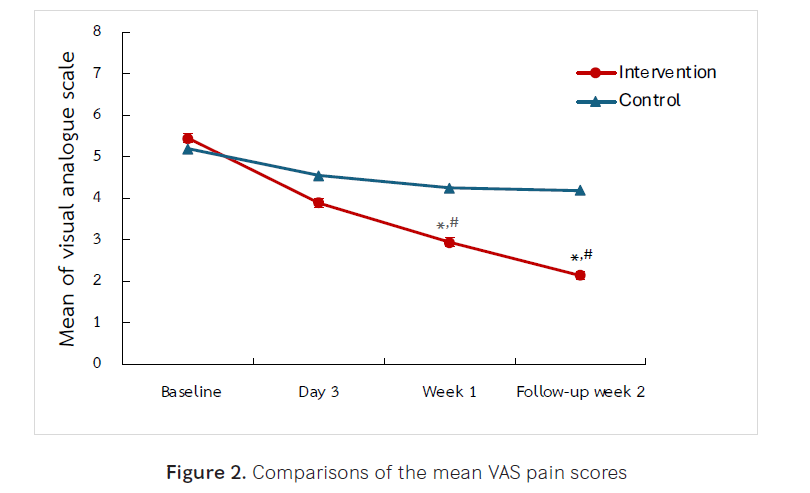Development of an Herbal Oil Formula for the Relief of Upper Back Pain in Office Syndrome
คำสำคัญ:
Herbal Oil, Office Syndrome, Upper Back Painบทคัดย่อ
Background and Purpose: Office syndrome is characterized by persistent pain in the same muscles. However, herbal oils used to treat office syndrome have an undesirable gooey consistency and leave yellow stains. This study aimed to use a cold extraction method to develop herbal oil in the form of coconut oil with extracts of the herbs Zingiber purpureum Roscoe, Z. officinale Roscoe, and Curcuma zedoaria (Christm.) Roscoe. Methods: This single-blind randomized clinical trial included 40 participants with upper back pain. Participants were divided equally into the intervention group who applied herbal oil twice daily on the painful areas for 1 week, and the control group who applied placebo oil. Outcome assessments included the general information, visual analog scale (VAS) for pain, trigger point pain assessed with an algometer, cervical range of motion (ROM), and satisfaction scores. Results: After 1 week of intervention and at 1 week after intervention cessation, the mean VAS for pain was significantly lower in the intervention group than the control group, and was significantly lower in the intervention group compared with baseline. The mean trigger point pain level was significantly lower in the intervention group than the control group after the intervention. In the intervention group, the mean lateral flexion ROMs were significantly better after 1 week of intervention compared with baseline. The overall satisfaction with the herbal oil was moderate. Conclusions: Using the cold extraction method created a coconut oil with herbal extracts that relieved pain but requires development to improve the consistency and staining.
Downloads
เอกสารอ้างอิง
Shariat A, Cardoso JR, Cleland JA, et al. Prevalence rate of neck, shoulder and lower back pain in association with age, body mass index and gender among Malaysian office workers. Work. 2018;60(2): 191-199. doi: 10.3233/WOR-2738.
Mongkonkansai J, Madardam U. Factor related to musculoskeletal disorders among office workers, Walailak University. J Health Sci. 2019;28(1): 37-44.
Division of Occupational and Environmental Diseases, Department of Disease Control, Ministry of Public Health. Annual Report 2016. Vol 1. Aksorn graphic and design publishing; 2017.
Leesiriwattanagu S, Charoenkit K, Pibanwong W. The effects of a Thai massage program on the office syndrome among personnel. Nurs J Minist Public Health. 2019;29(2): 129-141.
Chaiprakaiwan S. The efficacy and safety of Kati Basti by sesame oil and Num Man Kad Mon in low back pain. JTT Med Res. 2020;6(1): 35-44.
Kayum MA, Qaiyyum IA, Jabeen A, Nawab M. A review on pharmacological and therapeutic profile of zaranbad (Curcuma Zedoaria Rosc.). World J Pharm Sci. 2021;9(1): 60-66.
Sakpakdeejaroen I, Makchuchit S, Itharat A. Nitric oxide inhibitory activity of herbal extract formulae for anti-inflammation.TMJ. 2014;14(1): 7-12.
Bunpean A, Nicharojana L. Effects of massage with Plai juice and Plai oil on the relief of neck and shoulder pain: a study from Kanchanabhishek Institute of Medical and Public Health Technology.SCNJ. 2019;6(1): 121-130.
Lee SK, Hong CH, Huh SK, et al. Suppressive effect of natural sesquiterpenoids on inducible cyclooxygenase (COX-2) and nitric oxide synthase (iNOS) activity in mouse macrophage cells. J Environ Pathol Toxicol Oncol. 2002;21(2): 141-148.
Hayeeyahya W, Wongwiwat W, Jitjum S, Yamu N. Effect of Maneevej technique to relieve dysmenorrhea among reproductive aged females.TJPHS. 2021;4(2): 148-158.
Penprapai P, Intharit S. Total phenolic content and antioxidant activity of coconut oil enriched with some extracts of curcuma species in Thailand. J Appl Sci. 2017;16(Special): 48-54.
Dalpiaz A, Kuriki HU, Barbosa RAP, Diefenthaeler F, Marcolino AM, Barbosa RI. Dry needling and photobiomodulation decreases myofascial pain in trapezius of women: randomized blind clinical trial. J Manipulative Physiol Ther. 2021;44(1): 61-71. doi: 10.1016/j.jmpt.2020.07.002.
Phongvivat P. The result of local twitch response during treatment of myofascial pain syndrome in the upper trapezius muscle by trigger point injection technique: a retrospective study. Reg 11 Med. 2021;35(2): 1-13.
Murphy S, Buckle P, Stubbs D. Classroom posture and self-reported back and neck pain in schoolchildren. Appl Ergon. 2004;35(2): 113-120. doi:10.1016/j.apergo.2004. 01.001.
Thompho D, Sricha L, Chuchang S. The efficacy of Thai massage herbal compression and knee wraps in diabetic patients with knee osteoarthritis at Buayai Hospital, Buayai District, Nakhon Ratchasima Province. MJSBH. 2021;36(2): 391-401.
Wisuitiprot V, Bumrungchaichana W, Kaewtai N, et al. Effectiveness of a Plai oil prepared by Thai traditional medicine process in the treatment of myofascial pain syndrome: a randomized placebo-controlled trial. J Health Sci Med Res. 2019;37(3): 207-215. doi: 10.31584/jhsmr.201954.
Black CD, Herring MP, Hurley DJ, O’Connor PJ. Ginger (Zingiber officinale) reduces muscle pain caused by eccentric exercise. J Pain. 2010;11(9): 894-903. doi: 10.1016/ j.jpain.2009.12.013.
Manimmanakorn N, Manimmanakorn A, Boobphachart D, Thuwakum W, Laupattarakasem W, Hamlin MJ. Effect of Plai cream [Zingiber montanum (J. Koenig) Link ex A. Dietr. syn. Zingiber cassumunar Roxb.] combined with ultrasound on delayed onset muscle soreness. Indian J Tradit Knowl. 2017;16(3): 442-447.
Sadria G, Hosseini M, Rezasoltani A, Bagheban AA, Davari A, Seifolahi A. A comparison of the effect of the active release and muscle energy techniques on the latent trigger points of the upper trapezius. J Bodyw Mov Ther. 2017;21(4): 920-925. doi: 10.1016/j.jbmt.2016.10.005.
Yu J, Park D, Lee G. Effect of eccentric strengthening on pain, muscle strength, endurance, and functional fitness factors in male patients with Achilles tendinopathy. Am J Phys Med Rehabil. 2013;92(1): 68-76. doi: 10.1097/PHM. 0b013e31826eda63
Teehlek T, Bunpean A, Chantarapon P. Effect of thorn apple oil massage on neck and shoulder pain from office syndrome in students of Kanchanabhishek Institute of Medical and Public Health Technology. RMUTSV Res J. 2020;12(3): 408-419.

ดาวน์โหลด
เผยแพร่แล้ว
รูปแบบการอ้างอิง
ฉบับ
ประเภทบทความ
สัญญาอนุญาต
ลิขสิทธิ์ (c) 2024 ราชวิทยาลัยจุฬาภรณ์

อนุญาตภายใต้เงื่อนไข Creative Commons Attribution-NonCommercial-NoDerivatives 4.0 International License.
บทความที่ได้รับการตีพิมพ์เป็นลิขสิทธิ์ของราชวิทยาลัยจุฬาภรณ์
ข้อความที่ปรากฏในบทความแต่ละเรื่องในวารสารวิชาการเล่มนี้เป็นความคิดเห็นส่วนตัวของผู้เขียนแต่ละท่านไม่เกี่ยวข้องกับราชวิทยาลัยจุฬาภรณ์ และคณาจารย์ท่านอื่น ในราชวิทยาลัยฯ แต่อย่างใด ความรับผิดชอบองค์ประกอบทั้งหมดของบทความแต่ละเรื่องเป็นของผู้เขียนแต่ละท่าน หากมีความผิดพลาดใด ๆ ผู้เขียนแต่ละท่านจะรับผิดชอบบทความของตนเองแต่ผู้เดียว


